The Distinctive Role of Chemical Composition in Archaeometry. The Case of Apulian Red Figure Pottery
Abstract
1. Introduction
1.1. Archaeological Background
1.2. Analytical Methods and Multivariate Statistical Treatments
2. Archaeological Questions/Archaeometric Answers
2.1. Authenticity: Original Versus Fake
- (a)
- checking the nonauthenticity of a find or some parts of it, that could have been integrated during restoration (eventually, understanding where and when the integration was added); establishing the belonging of sporadic fragments to a single vase, when it is not possible based on well-known restoration procedures;
- (b)
- identify undocumented repainting on the surface of the vases. As a matter of fact, understanding if the surface of the vase is original is essential if you want to use nondestructive techniques, that inevitably analyze the more superficial layers.
- (a)
- Case study. Fragments: nonauthenticity or common origin.
- (b)
- Case study. Surfaces: undocumented repainting.
2.2. Provenance: Importation Versus Local Production
2.3. Workshops Location: Painters Transfer Versus Vases Transfer
2.4. Manufacture: Tradition Versus Innovation
3. Concluding Remarks
Author Contributions
Funding
Conflicts of Interest
References
- Hein, A.; Kilikoglou, V. Ceramic raw materials: How to recognize them and locate the supply basins: Chemistry. Archaeol. Anthropol. Sci. 2020, 12, 180. [Google Scholar] [CrossRef]
- Mommsen, H.; Sjöberg, B.L. The importance of the ‘best relative fit factor’ when evaluating elemental concentration data of pottery demonstrated with Mycenaean sherds from Sinda, Cyprus. Archaeometry 2007, 49, 357–369. [Google Scholar] [CrossRef]
- Glascock, M.D.; Neff, H.; Vaughn, K.J. Instrumental Neutron Activation Analysis and Multivariate Statistics for Pottery Provenance. Hyperfine Interact. 2004, 154, 95–105. [Google Scholar] [CrossRef]
- i Garrigós, J.B. Alteration and contamination of archaeological ceramics: The perturbation problem. J. Archeol. Sci. 1999, 26, 295–313. [Google Scholar] [CrossRef]
- Eramo, G.; Giannossa, L.C.; Rocco, A.; Mangone, A.; Graziano, S.F.; Laviano, R. Oil lamps from the catacombs of canosa (Apulia, fourth to sixth centuries ad): Technological features and typological imitation. Archaeometry 2014, 56, 375–391. [Google Scholar] [CrossRef]
- Giannossa, L.C.; Acquaviva, M.; Laganara, C.; Laviano, R.; Mangone, A. Applications of a synergic analytical strategy to figure out technologies in medieval glazed pottery with negative decoration from Italy. Appl. Phys. A 2014, 116, 1541–1552. [Google Scholar] [CrossRef]
- Giannossa, L.C.; Acquaviva, M.; De Benedetto, G.E.; Acquafredda, P.; Laviano, R.; Mangone, A. Methodology of a combined approach: Analytical techniques to identify the technology and raw materials used in thin-walled pottery from Herculaneum and Pompeii. Anal. Methods 2014, 6, 3490–3499. [Google Scholar] [CrossRef]
- Mangone, A.; Giannossa, L.C.; Ciancio, A.; Laviano, R.; Traini, A. Technological features of Apulian red figured pottery. J. Archaeol. Sci. 2008, 35, 1533–1541. [Google Scholar] [CrossRef]
- Mangone, A.; Giannossa, L.C.; Laganara, C.; Laviano, R.; Traini, A. Manufacturing expedients in medieval ceramics in Apulia. J. Cult. Herit. 2009, 10, 134–143. [Google Scholar] [CrossRef]
- Mangone, A.; De Benedetto, G.E.; Fico, D.; Giannossa, L.C.; Laviano, R.; Sabbatini, L.; Traini, A. Multianalytical study of archaeological faience from Vesuvian area as a valid tool to investigate provenance and technological features. New J. Chem. 2011, 35, 2860–2968. [Google Scholar] [CrossRef]
- Mangone, A.; Caggiani, M.C.; Giannossa, L.C.; Eramo, G.; Redavid, V.; Laviano, R. Diversified production of red figured pottery in Apulia (Southern Italy) in the late period. J. Cult. Herit. 2013, 14, 82–88. [Google Scholar] [CrossRef]
- Aruga, R.; Mirti, P.; Casoli, A. Application of multivariate chemometric techniques to the study of Roman pottery (terra sigillata). Anal. Chi. Acta 1993, 276, 197–204. [Google Scholar] [CrossRef]
- Mangone, A.; Giannossa, L.C.; Laviano, R.; Fioriello, C.S.; Traini, A. Investigations by various analytical techniques to the correct classification of archaeological finds and delineation of technological features. Late Roman lamps from Egnatia: From imports to local production. Microchem. J. 2009, 91, 214–221. [Google Scholar] [CrossRef]
- Mirti, P.; Gulmini, M.; Pace, M.; Elia, D. The provenance of red figure vases from Locri Epizephiri (southern Italy): New evidence by chemical analyses. Archaeometry 2004, 46, 183–200. [Google Scholar] [CrossRef]
- Mirti, P.; Perardi, A.; Gulmini, M.; Preacco, M.C. A scientific investigation in the provenance and technology of a black-figure amphora attributed to the Priam group. Archaeometry 2006, 48, 31–43. [Google Scholar] [CrossRef]
- Massart, D.L.; Vandeginste, B.G.; Deming, S.N.; Michotte, Y.; Kaufman, L. Principal Components and Factor Analysis Chemometrics: A Textbook; Elsevier: Amsterdam, The Netherlands, 1988. [Google Scholar]
- Neff, H. Chemical Characterization of Ceramic Pastes in Archaeology; Prehistory Press: Madison, WI, USA, 1992. [Google Scholar]
- Aruga, R. The problem of responses less than the reporting limit in unsupervised pattern recognition. Talanta 2004, 62, 871–878. [Google Scholar] [CrossRef]
- Bellanti, F.; Tomassetti, M.; Visco, G.; Campanella, L. A chemometric approach to the historical and geographical characterization of different terracotta finds. Microchem. J. 2008, 88, 113–120. [Google Scholar] [CrossRef]
- Pizarro, C.; Pérez del Notario, N.; Sáenz González, C.; Rodríguez Tecedor, S.; González Sáiz Depa, J.M. Matching past and present ceramic production in the banda area (Ghana). Archaeometry 2012, 54, 101–113. [Google Scholar] [CrossRef]
- Remolà, J.A.; Lozano, J.; Ruisánchez, I.; Larrechi, M.S.; Rius, F.X.; Zupan, J. New chemometric tools to study the origin of amphorae produced in the Roman Empire. Trends Anal. Chem. 1996, 15, 137–150. [Google Scholar] [CrossRef]
- Maggetti, M. Phase analysis and its significance for technology and origin. In Archeological Ceramics; Olin, J.S., Ed.; Smithsonian Institution Press: Boston, MA, USA, 1982; pp. 121–133. [Google Scholar]
- Maggetti, M.; Neururer, C.; Ramseyer, D. Temperature evolution inside a pot during experimental surface (bonfire) firing. Appl. Clay Sci. 2011, 53, 500–508. [Google Scholar] [CrossRef]
- Maritan, L.; Nodari, L.; Mazzoli, C.; Milano, A.; Russo, U. Influence of firing conditions on ceramic products: Experimental study on clay rich in organic matter. Appl. Clay Sci. 2006, 31, 1–15. [Google Scholar] [CrossRef]
- Riccardi, M.P.; Messiga, B.; Duminuco, P. An approach to the dynamics of clay firing. Appl. Clay Sci. 1999, 15, 393–409. [Google Scholar] [CrossRef]
- Tite, M.S. Firing temperature determinations how and why? In The Aim of Laboratory Analyses of Ceramics in Archeology, Proceedings of the Kungliga Vitterhets Historie Och Antikvitets Akademien Konferenser, Lund, Sweden, 7–9 April 1995; Coronet Books Inc: Philadelphia, PA, USA, 1995; Volume 34, pp. 37–42. ISBN 91-7402-258-X. [Google Scholar]
- Giannossa, L.C.; Laviano, R.; Mastrorocco, F.; Giannelli, G.; Muntoni, I.M.; Mangone, A. A pottery jigsaw puzzle: Distinguish true and false pieces in two Apulian red figured vases by a poli-technique action plan. Appl. Phys. A 2016, 122, 68–77. [Google Scholar] [CrossRef]
- Giannossa, L.C.; Giacobello, F.; Muntoni, I.M.; Laviano, R.; Caggiani, M.C.; Mastrorocco, F.; Mangone, A. An analytical techniques pool to hit the target. A comprehensive examination on an Apulian red figured pottery collection. Microchem. J. 2017, 134, 354–361. [Google Scholar] [CrossRef]
- Giannossa, L.C.; Mininni, R.M.; Laviano, R.; Mastrorocco, F.; Caggiani, M.C.; Mangone, A. An archaeometric approach to gain knowledge on technology and provenance of Apulian red figured pottery from Taranto. Archaeol. Anthrop. Sci. 2017, 9, 1125–1135. [Google Scholar] [CrossRef]
- Giannossa, L.C.; Muntoni, I.M.; Laviano, R.; Mangone, A. Contribution of mineralogical and analytical techniques to investigate provenance and technologies of Hellenistic pottery from Arpi (Southern Italy). J. Archaeol. Scie. Rep. 2019, 24, 729–737. [Google Scholar] [CrossRef]
- Giannossa, L.C.; Muntoni, I.M.; Laviano, R.; Mangone, A. Building a step by step result in archaeometry. Raw materials, provenance and production technology of Apulian Red Figure pottery. J. Cult. Herit. 2020, 43, 242–248. [Google Scholar] [CrossRef]
- Mangone, A.; Giannossa, L.C.; Colafemmina, G.; Laviano, R.; Traini, A. Use of various spectroscopy techniques to investigate raw materials and define processes in the overpainting of Apulian red figured pottery (4th century BC) from Southern Italy. Microchem. J. 2009, 92, 97–102. [Google Scholar] [CrossRef]
- Trendall, A.D.; Cambitoglou, A. The Red-Figured Vases of Apulia, Volume I: Early and Middle Apulian. Am. J. Archeol. 1980, 84, 110–112. [Google Scholar]
- Trendall, A.D.; Cambitoglou, A. The Red-Figured Vases of Apulia, Volume II: Late Apulian. L’Antiquité Classique 1985, 54, 529–531. [Google Scholar]
- Trendall, A.D. Red Figure Vases of South Italy and Sicily (World of Art) A Handbook; Thames & Hudson: London, UK, 1989. [Google Scholar]
- Mangone, A.; Giannossa, L.C.; Ciancio, A.; Laviano, R.; Traini, A. Indagini Archeometriche Sulla Ceramica Apula a Figure Rosse Proveniente da Siti della Puglia Centrale, Proceedings of the Atti convegno di archeometria della Ceramica, Rutigliano, Bari, Italy, 18 January 2004; Ciancio, A., Ed.; L’artigiangrafica Guarnieri: Rutigliano, Italy, 2008; pp. 83–103. [Google Scholar]
- Aloupi-Siotis, E. Recovery and revival of attic vase-decoration techniques. What can it offer to archaeological research? In Papers on Special Techniques in Athenian Vases, Proceedings of The Colors of Clay: Special Techniques in Athenian Vases; Lapatin, K., Ed.; Getty Pubblications: Los Angeles, CA, USA, 2008; pp. 113–127. [Google Scholar]
- Aloupi-Siotis, E. Ceramic technology: How to haracterize black Fe-based glass-ceramic coatings. Archaeol. Anthropol. Sci. 2020, 12, 191. [Google Scholar] [CrossRef]
- Bente, K.; Sobott, R.; Berthold, C. Phase analytical and microstructural study of black glosses on Attic red-figure vases by XRD (GADDS), Mössbauer spectroscopy, and TEM. In Naturwissenschaftliche Analysen vor und fruhgeschichtlicher Keramik 3. Methoden, Anwendungsbereiche, Auwertungmoglichkeiten; Ramminger, B., Stillborg, O., Helfert, M., Eds.; Universitätsforschungen zur prähistorischen Archäologie: Bonn, Germany, 2013; pp. 273–288. [Google Scholar]
- Bimson, M. The technique of Greek Black and Terra Sigillata red. Antiq. J. 1956, 36, 200–204. [Google Scholar] [CrossRef]
- Binns, C.F.; Fraser, A.D. Genesis of the Greek Black Glaze. Am. J. Archaeol. 1929, 33, 1–9. [Google Scholar] [CrossRef]
- Chaviara, A.; Aloupi-Siotis, E. The story of a soil that became a glaze: Chemical and microscopic fingerprints on the Attic vases. J. Archaeol. Scie. Rep. 2016, 7, 510–518. [Google Scholar] [CrossRef]
- Cianchetta, I.; Trentelman, K.; Maish, J.; Saunders, D.; Foran, B.; Walton, M.; Pianetta, P. Evidence for an unorthodox firing sequence employed by the Berlin Painter: Deciphering ancient ceramic firing conditions through high resolution material characterization and replication. J. Anal. At. Spectrom. 2015, 30, 666–676. [Google Scholar] [CrossRef]
- Cianchetta, I.; Maish, J.; Saunders, D.; Walton, M.; Mehta, A.; Foran, B.; Trentelman, K. Investigating the firing protocol of Athenian pottery production: A Raman study of replicate and ancient sherds. J. Raman Spectrosc. 2015, 46, 996–1002. [Google Scholar] [CrossRef]
- Cianchetta, I.; Trentelman, K.; Walton, M.S.; Maish, J.; Mehta, A.; Foran, B.; Cianchetta, I.; Trentelman, K.; Walton, M.S.; Maish, J.; et al. Reverse Engineering Ancient Greek Ceramics: Morphological and Spectral Characterization of Replicates. J. Am. Ceram. Soc. 2016, 99, 1792–1801. [Google Scholar] [CrossRef]
- Farnsworth, M.; Wisely, H. Fifth century intentional red glaze. Am. J. Archaeology 1958, 62, 165–173. [Google Scholar] [CrossRef]
- Farnsworth, M.; Simmons, I. Colouring agents for Greek glazes. Am. J. Archaeol. 1963, 67, 389–396. [Google Scholar] [CrossRef]
- Hofmann, U. The chemical basis of ancient Greek vase painting. Angew. Chem. 1962, 1, 341–350. [Google Scholar] [CrossRef]
- Hofmann, U. Die Chemie der antiken Keramik. Naturwissenshaften 1966, 53, 218–223. [Google Scholar] [CrossRef]
- Ingo, G.M.; Bultrini, G.; de Caro, T.; Del Vais, C. Microchemical study of the black gloss on red and black-figured Attic vases. Surf. Interface Anal. 2000, 30, 101–105. [Google Scholar] [CrossRef]
- Jones, R.E. Greek and Cypriot Pottery: A Review of Scientific Studies; British School at Athens: Athens, Greece, 1986. [Google Scholar]
- Kingery, W.D. Attic pottery gloss technology. Archeomaterials 1991, 5, 47–54. [Google Scholar]
- Longworth, G.; Tite, M.S. Mossbauer studies on the nature of red or black glazes on Greek and Indian painted ware. J. Phys. 1979, 40, 460–461. [Google Scholar] [CrossRef]
- Lühl, L.; Hesse, B.; Mantouvalou, I.; Wilke, M.; Mahlkow, S.; Aloupi-Siotis, E.; Kanngiesser, B. Confocal XANES and the Attic Black Glaze: The Three-Stage Firing Process through Modern Reproduction. Anal. Chem. 2014, 86, 6924–6930. [Google Scholar] [CrossRef]
- Maniatis, Y.; Aloupi, E.; Stalios, A.D. New evidence for the nature of the Attic black gloss. Archaeometry 1993, 35, 23–34. [Google Scholar] [CrossRef]
- Mirti, P. X-ray microanalysis discloses the secrets of ancient Greek and Roman potters. X-ray Spectrom. 2000, 29, 63–72. [Google Scholar] [CrossRef]
- Naudé, C.P. The glaze technique of the Attic vase. In Acta Classica 2, Proceedings of the Classical Association of South Africa; Classical Association of South Africa: Pretoria, South Africa, 1959; pp. 106–116. [Google Scholar]
- Noble, J.V. The technique of Attic vase painting. Am. J. Archaeology 1960, 64, 307–313. [Google Scholar] [CrossRef]
- Noble, J.V. The Techniques of Painted Attic Pottery; Watson-Guptill Publications: New York, NY, USA, 1965. [Google Scholar]
- Noll, W.; Holm, R.; Born, L. Material und techniken antiker vasenmalerei. Jahrbuch der Staatlichen Kunstsammlungen; Band X: Baden-Wurttemberg, Germany, 1973; Volume 1, pp. 103–126. [Google Scholar]
- Noll, W.; Holm, R.; Born, L. Bemalung antiker Keramik. Angew. Chem. 1975, 87, 639–651. [Google Scholar] [CrossRef]
- Noll, W.; Holm, R.; Born, L. Painting of Ancient Ceramics. Angew. Chem. Int. Ed. 1975, 4, 602–613. (In English) [Google Scholar] [CrossRef]
- Pavicevic, M. Untersuchung der schwarzen Malschicht attischer Vasen mit der Elektronenmikrosonde. Ber. Dt. Keram. Ges. 1974, 51, 61–63. [Google Scholar]
- Robinson, E. Archaeometric analysis of Apulian and Lucanian red-figure pottery. In The Italic People of Ancient Apulia: New Evidence from Pottery for Workshops, Markets and Customs; Carpenter, T., Lynch, K., Robinson, E., Eds.; Cambridge University Press: Cambridge, UK, 2014; pp. 243–264. [Google Scholar]
- Schumann, T. Oberflachenverzierung in der antiken Topferkunst, Terra sigillata und griechische Schwarzrotmalerei. Ber. Dt. Keram. Ges. 1942, 23, 408–426. [Google Scholar]
- Tang, C.C.; MacLean, E.J.; Roberts, M.A.; Clarke, D.T.; Pantos, E.; Prag, A.J. The study of Attic black gloss sherds using synchrotron X-ray diffraction. J. Archaeol. Sci. 2001, 28, 1015–1024. [Google Scholar] [CrossRef]
- Tite, M.S.; Bimson, M.; Freestone, I.C. An examination of the high gloss surfaces finishes on Greek Attic and Roman Samian wares. Archaeometry 1982, 24, 117–126. [Google Scholar] [CrossRef]
- Walton, M.; Trentelman, K.; Cummings, M.; Poretti, G.; Maish, J.; Saunders, D. Material Evidence for Multiple Firings of Ancient Athenian Red-Figure Pottery. J. Am. Ceram. Soc. 2013, 96, 2031–2035. [Google Scholar] [CrossRef]
- Walton, M.; Trentelman, K.; Cianchetta, I.; Maish, J.; Saunders, D.; Foran, B.; Mehta, A. Zn in Athenian black gloss ceramic slips: A trace element marker for fabrication technology. J. Am. Ceram. Soc. 2014, 98, 430–436. [Google Scholar] [CrossRef]
- Winter, A. Die Technik des giechischen Topfers in ihren Grundlagen, Tech Beitrage zur Archaologie 1; Rom germanisches Zentralmuseum: Mainz, Germany, 1959. [Google Scholar]
- Artal-Isbrand, P.; Klausmeyer, P. Evaluation of the relief line and the contour line on Greek red-figure vases using reflectance transformation imaging and three-dimensional laser scanning confocal microscopy. Stud. Conserv. 2013, 58, 338–359. [Google Scholar] [CrossRef]
- Pérez, J.M.; Esteve-Tébar, R. Pigment identification in Greek pottery by Raman microspectroscopy. Archaeometry 2004, 46, 607–614. [Google Scholar] [CrossRef]
- Ambrosini, L.; Felici, A.C.; Fronterotta, G.; Piacentini, M.; Vendittelli, M. Non Destructive Analysis of a Red Figure Vase of Uncertain Attribution from Falerii Veteres. In Proceedings of the EMAC’07 9th European Meeting on Ancient Ceramics, Budapest, Hungary, 24–27 October 2007; Birò, K., Szilàgyi, V., Kreiter, A., Eds.; Hungarian National Museum: Budapest, Hungary, 2007. [Google Scholar]
- Barilaro, D.; Crupi, V.; Interdonato, S.; Longo, S.; Maisano, G.; Majolino, D.; Venuti, V.; Barone, G.; Mazzoleni, P.; Tigano, G.; et al. Archaeometric investigation of red-figure pottery fragments from Gioiosa Guardia (Messina, Sicily) by INAA, FT-IR and TOF-ND techniques. Il Nuovo Cimento C 2008, 31, 371–388, ISSN 1826-9885. [Google Scholar]
- Bitetto, A.; Mangone, A.; Mininni, R.M.; Giannossa, L.C. A nonlinear principal component analysis to study archeometric data. J. Chemometrics 2016, 30, 405–415. [Google Scholar] [CrossRef]
- Grave, P.; Robinson, E.; Barbetti, M.; Yu, Z.; Bailey, G.; Bird, R. Analysis of south Italian pottery by PIXE-PIGME. Meditarch 1997, 9/10, 113–125. [Google Scholar]
- Mastrorocco, F. Chemical and Molecular Sciences, Innovative Approach in LA-ICPMS Implementation Cases in Cultural Heritage by NPs Deposition. Ph.D. Thesis, University of Bari Aldo Moro, Bari, Italy, 2015–2018. [Google Scholar]
- Mirti, P.; Casoli, A.; Barra Bagnasco, M.; Preacco Ancona, M.C. Fine ware from Locri Epizephiri: A provenance study by Inductively Coupled Plasma Emission Spectroscopy. Archaeometry 1995, 37, 41–51. [Google Scholar] [CrossRef]
- Thorn, J.; Glascock, M. New evidence for Apulian red-figure production centres. Archaeometry 2010, 52, 777–795. [Google Scholar] [CrossRef]
- Laviano, R.; Muntoni, I.M. Analisi archeometriche sulle ceramiche a figure rosse dalla tomba 33 di Timmari: Provenienza delle materie prime e tecnologie di manifattura di alcune opere del Pittore di Dario. In Una Tomba Principesca da Timmari; Canosa, M., Bretschneider, G., Eds.; Accademia Nazionale dei Lincei: Roma, Italy, 2007; pp. 179–205. [Google Scholar]
- Mangone, A.; Giannossa, L.C.; Caggiani, M.C.; Laviano, R.; Redavid, V.; Traini, A. Late Red Figured Pottery from Egnatia (Southern Italy): Attic Tradition and Apulian technological Innovation, Proceedings of the 4th International Congress on Science and Technology for the Safeguard of Cultural Heritage in the Mediterranean Basin, Cairo, Egypt, 6–8 December 2009; Grafica Eletronica srl: Naples, Italy, 2010; pp. 321–326. ISBN 978-88-96680-32-2. [Google Scholar]
- Mangone, A.; Giannossa, L.C.; Colafemmina, G.; Laviano, R.; Redavid, V.; Traini, A. Gnathia and Red Figured Pottery from Apulia: Continuity of a Production Technology. In Proceedings of the International Symposium on Archaeometry, Siena, Italy, 12–16 May 2008; Springer: Berlin, Germany, 2011; pp. 99–104. [Google Scholar]
- Mirti, P.; Casoli, A.; Calzetti, L. Technology of production of fine pottery excavated on a western Greek site investigated by Scanning Electron Microscopy coupled with Energy-Dispersive X-ray detection. X-ray Spectrom. 1996, 25, 103–109. [Google Scholar] [CrossRef]
- Mirti, P.; Gulmini, M.; Perardi, A.; Davit, P.; Elia, D. Technology of production of red figure pottery from Attic and southern Italian workshops. Anal. Bional. Chem. 2004, 380, 712–718. [Google Scholar] [CrossRef]
- Barca, D.; La Russa, M.F.; Crisci, G.M. Technological and geochemical study of two red-figured vases of unknown provenance by various analytical techniques. Appl. Phys. A 2010, 100, 911–917. [Google Scholar] [CrossRef]
- Bonacci, P.; Guiducci, S. Alla Ricerca Dell’Arte Perduta; Il Formichiere: Perugia, Italy, 2018. [Google Scholar]
- Hatcher, H.; Hedges, R.E.M.; Pollard, A.M.; Kenrick, P.M. Analysis of Hellenistic and Roman fine pottery from Benghazi. Archaeometry 1980, 22, 133–151. [Google Scholar] [CrossRef]
- Miller, J.N.; Miller, J.C. Statistics and Chemometrics for Analytical Chemistry, 6th ed.; Prentice Hall: Upper Saddle River, NJ, USA, 2009. [Google Scholar]
- Alaimo, R.; Bultrini, G.; Eragalà, I.; Giarrusso, R.; Illiopoulos, I.; Montana, G. Archaeometry of Sicilian glazed pottery. Appl. Phys. A Mater. Sci. Process. 2004, 9, 221–227. [Google Scholar] [CrossRef]
- Vannoorenberghe, M.; Van Acker, T.; Belza, J.; Teetaert, D.; Crombé, P.; Vanhaecke, F. Multi-element LA-ICP-MS analysis of the clay fraction of archaeological pottery in provenance studies: A methodological investigation. J. Anal. At. Spectrom. 2020, 35, 2686–2696. [Google Scholar] [CrossRef]
- Hall, M.E. Pottery styles during the early Jomon period: Geochemical perspectives on the Moroiso and Ukishima pottery styles. Archaeometry 2007, 43, 59–75. [Google Scholar] [CrossRef]
- Ripley, B.; Venables, B.; Bates, D.M.; Hornik, K.; Gebhardt, A.; Firth, D. Package ‘MASS’. Cran-R Project; The R Foundation: Vienna, Austria, 2019. [Google Scholar]
- Stacklies, W.; Redestig, H.; Scholz, M.; Walther, D.; Selbig, J. The ‘pcaMethods’ Package. Bioinformatics; Max Planck Institute for Molecular Plant Physiology: Potsdam, Germany, 2007. [Google Scholar]
- Knelman, J. A brief history of art theft. Queens Quart. 2011, 118, 222–233. [Google Scholar]
- Chen, F.; Regan, R. Arts and craftiness: An economic analysis of art heists. J. Cult. Econ. 2017, 41, 283–307. [Google Scholar] [CrossRef]
- Amineddoleh, L. The Role of Museums in the Trade of Black Market. Cultural Heritage Property. Art Antiq. Law 2013, 18, 227–254. [Google Scholar]
- Melillo, L.; Operetto, M. Pittore di Varrese (attribuito a) Loutrophoros apula a figure rosse 350-340 a.C., relazione di restauro. In Restituzioni 2013; Bertelli, C., Bonsanti, G., Eds.; Tesori D’Arte Restaurati, Marsilio: Venice, Italy, 2013. [Google Scholar]
- Giannossa, L.C. Ceramica Apula a Figure Rosse: Indagine Archeometrica di Reperti dai Siti di Monte Sannace ed Arpi. Master’s Thesis, Dipartimento di Chimica, Università degli Studi di Bari Aldo Moro, Bari, Italy, 2004–2005. [Google Scholar]
- Mangone, A.; Laviano, R.; Giannossa, L.C.; Muntoni, I.M. Archeometria di due Restauri. Giornata Internazionale di Studio—Savoir-Faire Antichi e Moderni: Tra Ruvo di Puglia e Napoli. Il Caso del Cratere dell’Amazzonomachia e di Una Loutrophoros con il mito di Niobe; Giacobello, F., Pouzadoux, C., Eds.; Centre Jean Berard: Naples, Italy, 2020; pp. 95–110. [Google Scholar]
- Castoldi, M. I vasi a figure rosse del periodo protoapulo e apulo antico: Taranto e le officine ceramiche. In Ceramiche Attiche e Magnogreche, Collezione Banca Intesa; Sena Chiesa, G., Slavazzi, F., Eds.; Electa: Milano, Italy, 2006; pp. 178–181. [Google Scholar]
- Dell’Aglio, A. La forma della città: Aree e strutture di produzione artigianale. Taranto e il Mediterraneo. In Proceedings of the 41st Convegno di Studi sulla Magna Grecia, Taranto, Italy, 2–16 October 2001; Istituto per la storia e l’archeologia della Magna Grecia: Taranto, Italy, 2002; pp. 171–193. [Google Scholar]
- De Juliis, E.M. La Tomba del Vaso dei Niobidi di Arpi; Edipuglia: Bari, Italy, 1992. [Google Scholar]
- Corrente, M. 1912 un Ipogeo al Confine: La Tomba Varrese; Alfagrafica Volonnino: Potenza, Italy, 2004. [Google Scholar]
- Giacobello, F. Pittore di Dario (attribuito a) Kratere apulo a figure rosse detto ‘Vaso dell’Amazzonomachia’ 330 a.C. ca. In Restituzioni 2013; Bertelli, C., Bonsanti, G., Eds.; Tesori d’arte restaurati: Venezia, Italy, 2013; pp. 78–83. [Google Scholar]
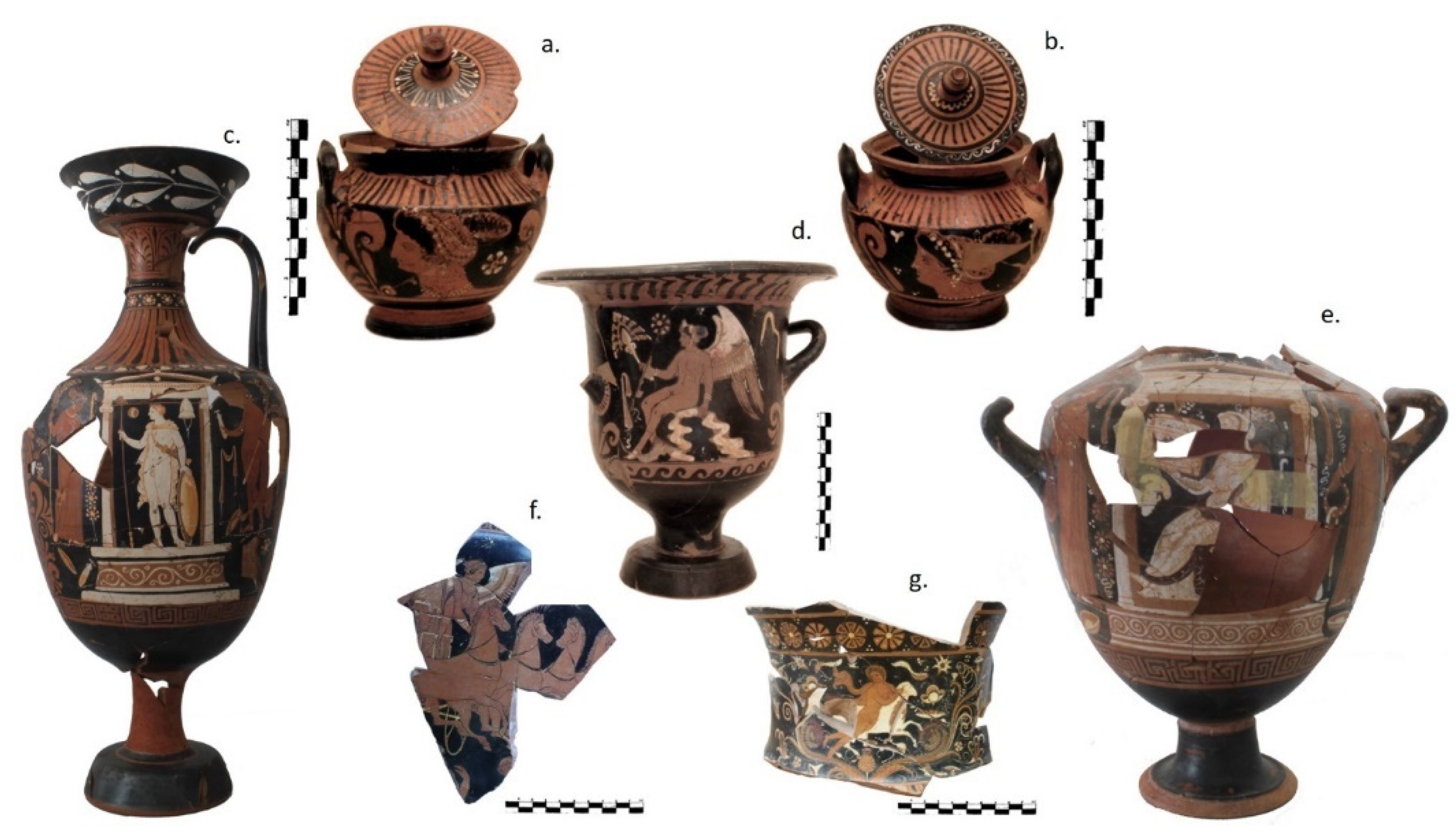
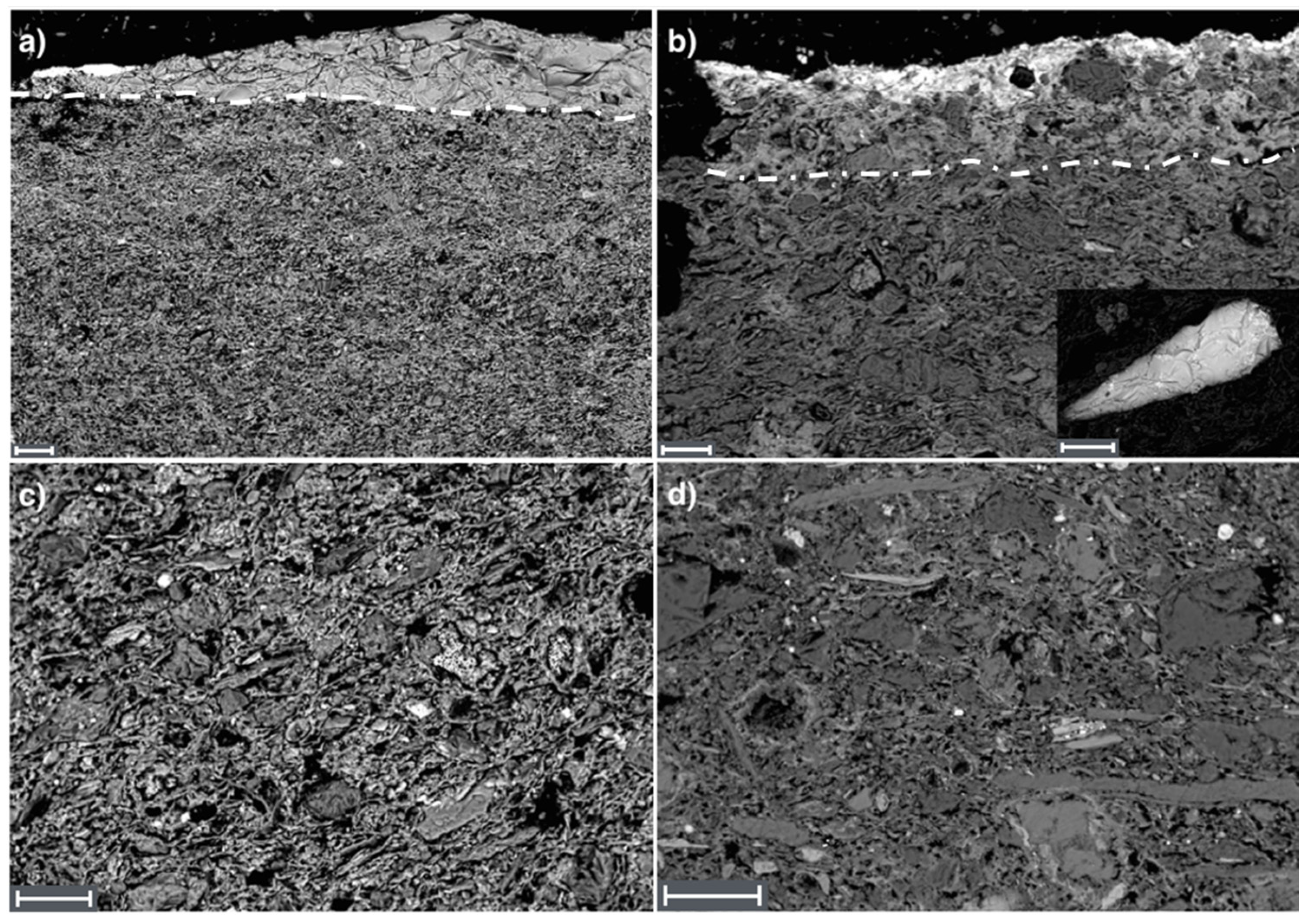
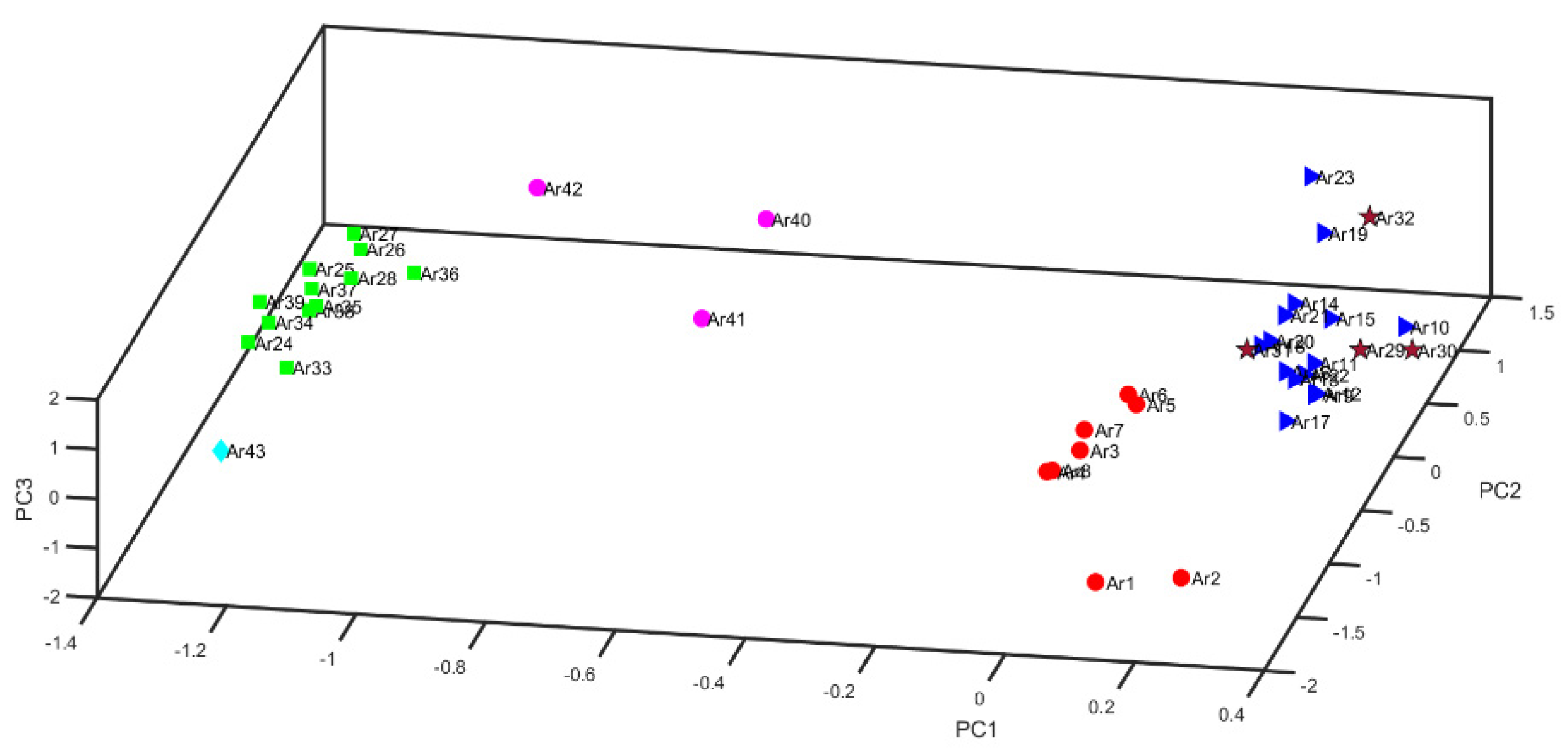
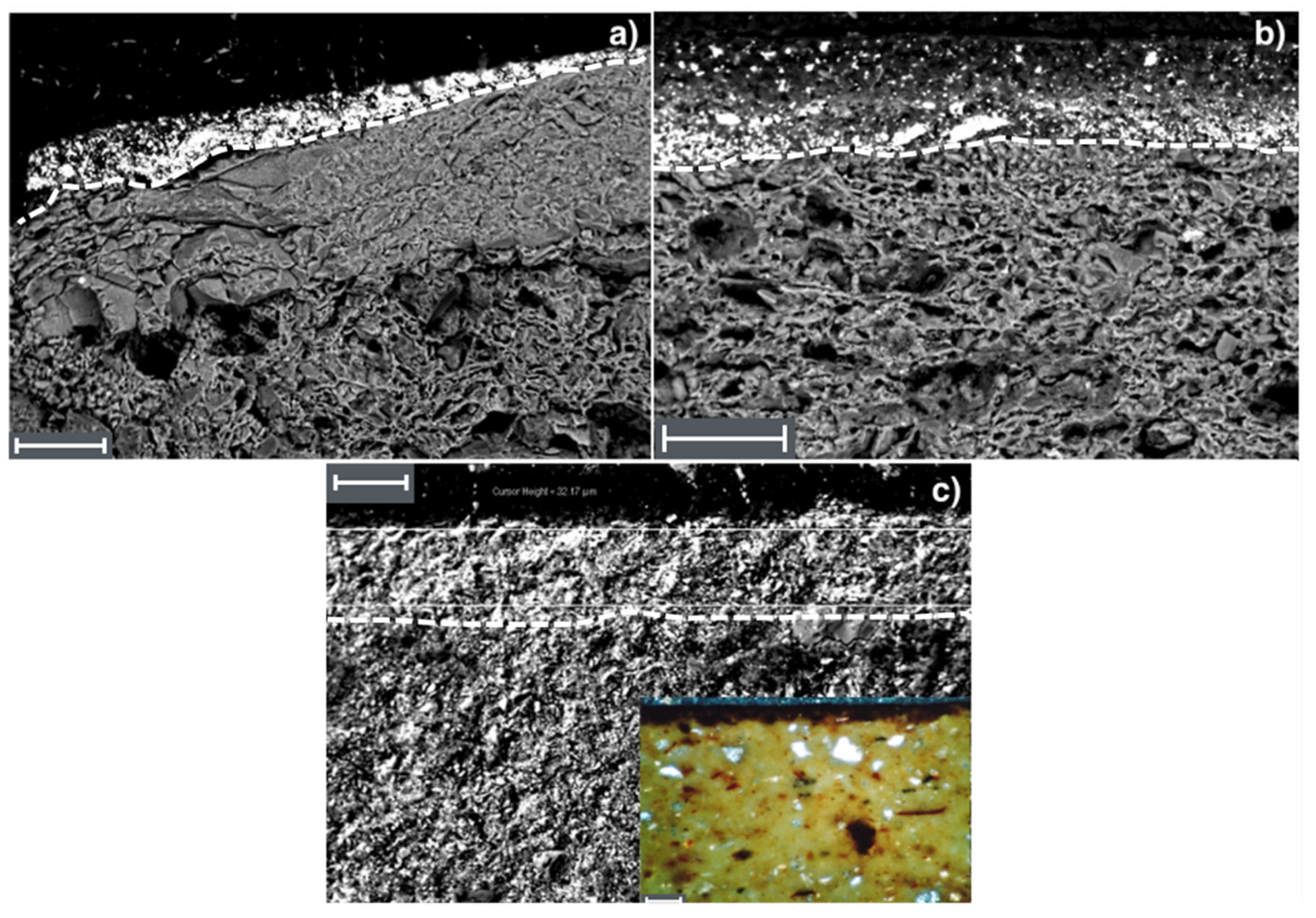
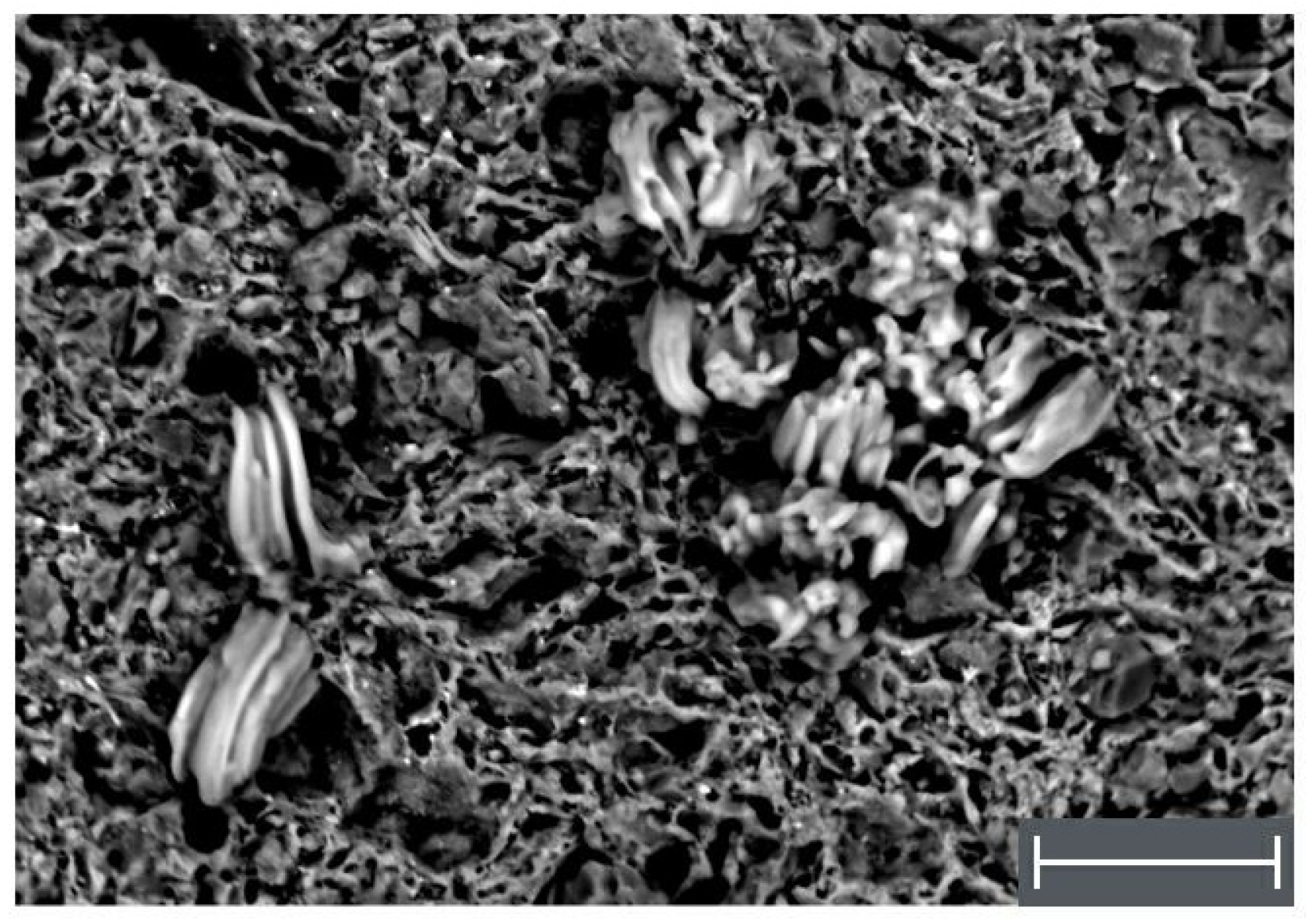
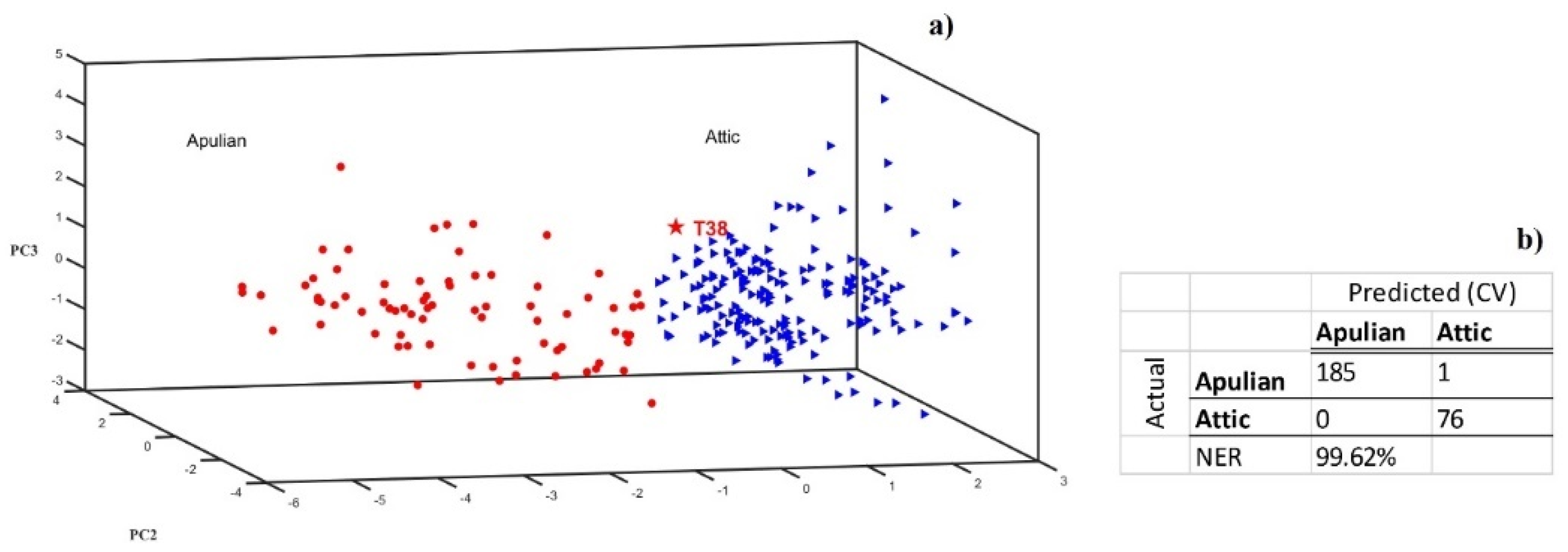
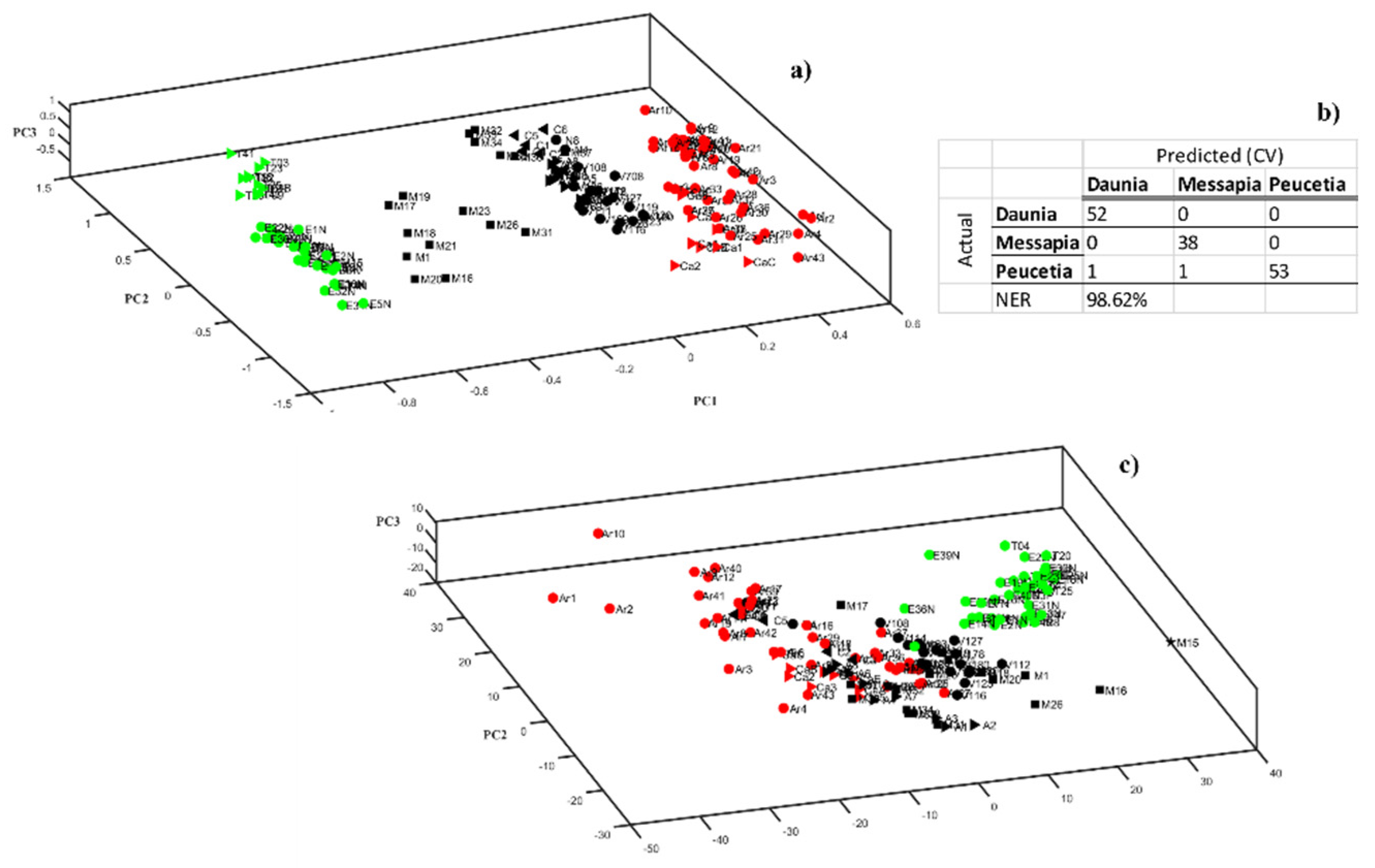
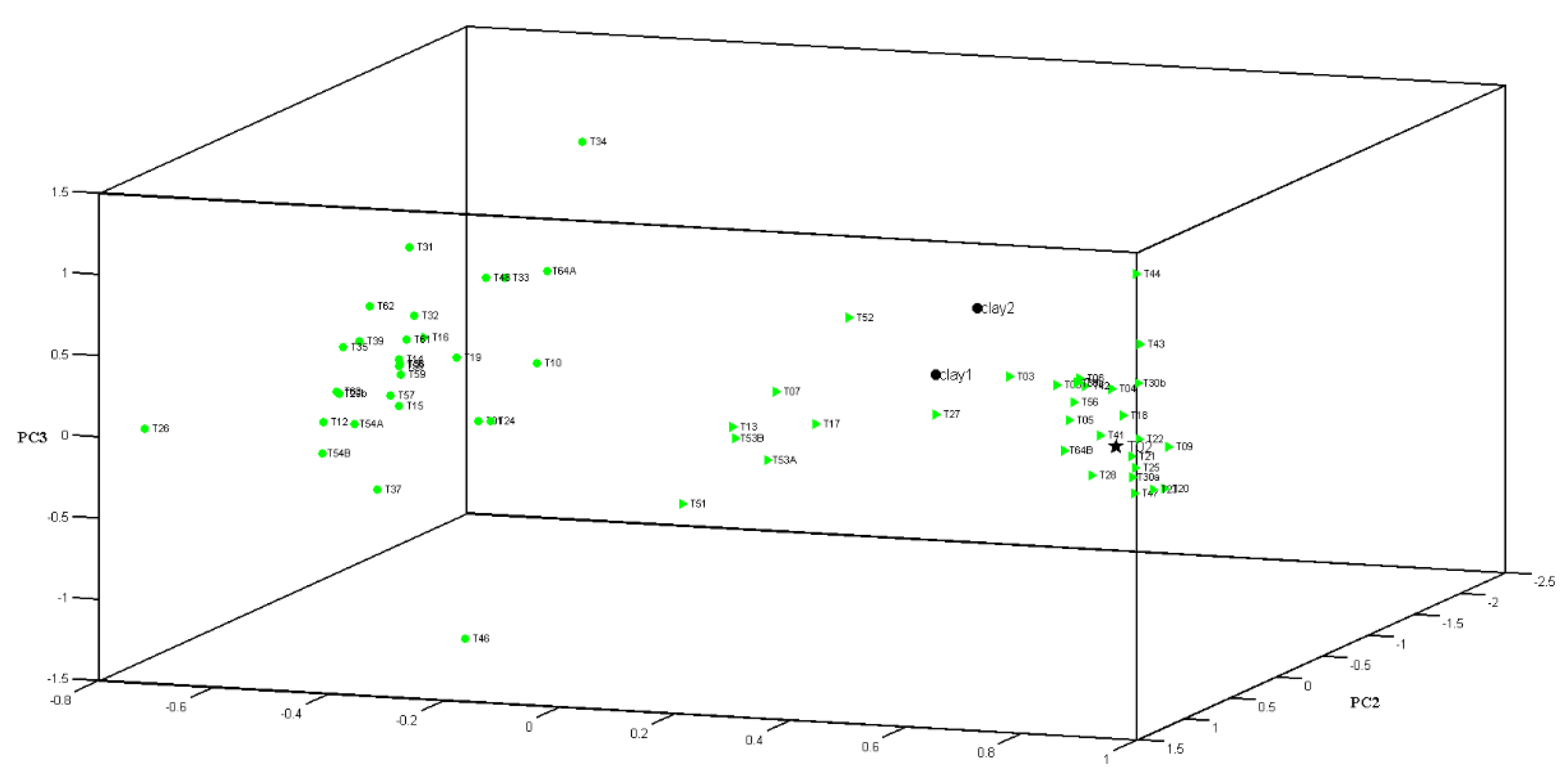

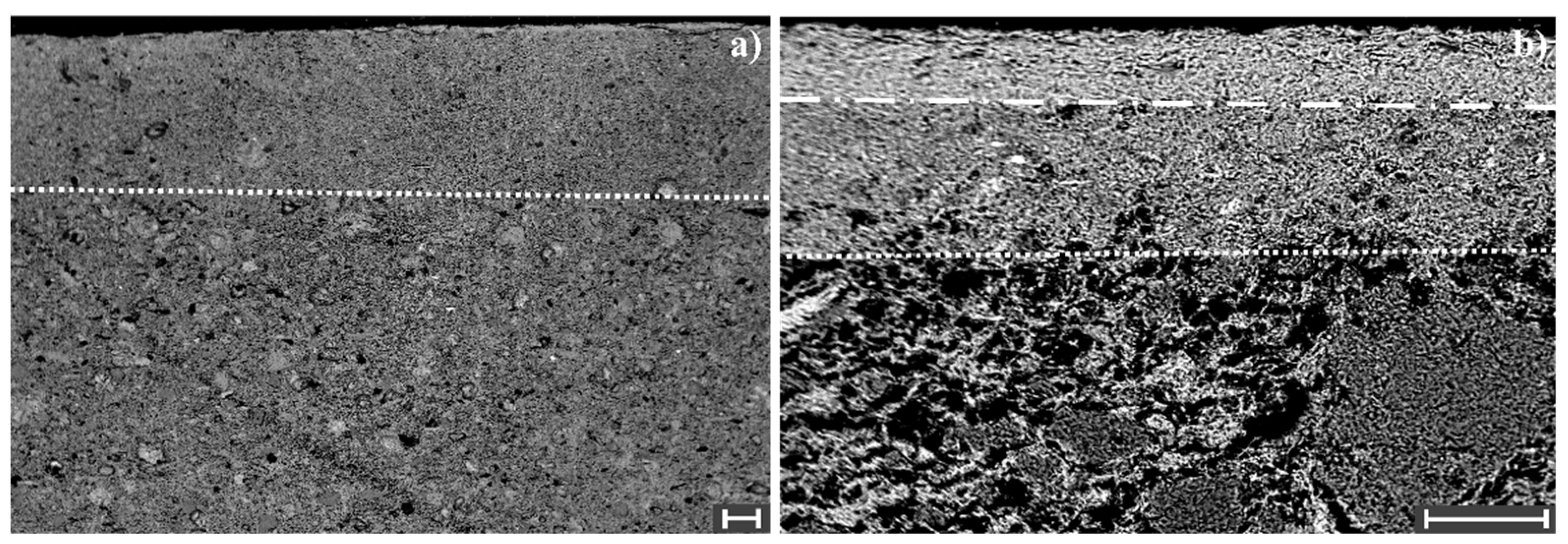
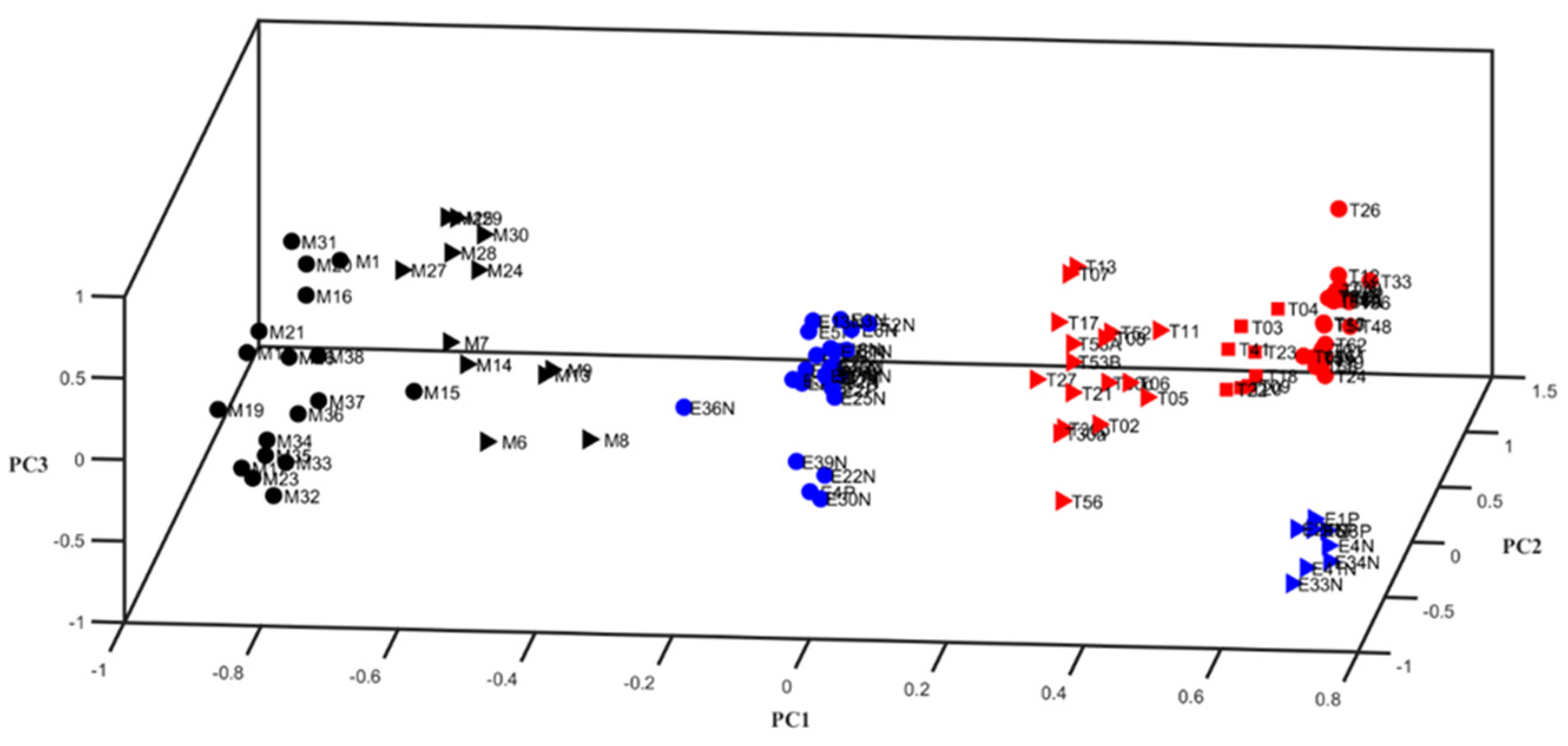
| Sample | Fe | Al | Mg | K | Ti | Na | Ca | Mn | Pb | Ni | Sr | Cr | Ba | Zn |
|---|---|---|---|---|---|---|---|---|---|---|---|---|---|---|
| (% w/w) | (ppm) | |||||||||||||
| Krater basin | 5.17 | 9.96 | 1.48 | 2.38 | 0.55 | 0.72 | 6.70 | 959 | 192 | 78 | 316 | 131 | 407 | 131 |
| Krater handle | 2.96 | 9.24 | 0.55 | 2.56 | 0.32 | 0.62 | 7.55 | 865 | 1256 | 28 | 123 | 51 | 364 | 43 |
| Cercine | 4.20 | 10.89 | 1.93 | 2.57 | 0.43 | 0.74 | 7.89 | 740 | 811 | 63 | 386 | 141 | 295 | 99 |
| Loutrophoros foot | 5.01 | 8.99 | 1.37 | 2.26 | 0.51 | 0.54 | 6.99 | 1267 | 57 | 68 | 280 | 102 | 350 | 119 |
| Loutrophoros basin | 5.04 | 8.89 | 1.39 | 2.26 | 0.51 | 0.51 | 6.54 | 1126 | 34 | 88 | 310 | 133 | 388 | 117 |
| Loutrophoros neck | 3.91 | 5.70 | 1.66 | 1.87 | 0.33 | 1.91 | 11.41 | 658 | 183 | 142 | 745 | 343 | 328 | 137 |
| Loutrophoros neck edge | 3.90 | 7.09 | 1.85 | 2.15 | 0.38 | 0.60 | 8.92 | 956 | 10,869 | 70 | 456 | 103 | 422 | 164 |
| Code | Inv. n° | Description | Site |
|---|---|---|---|
| Ar2 | 132734 | Oinochoe, Tomb of Niobids | Arpi |
| Ca2 | 8925 | Deinos, Hypogeum of Varrese | Canosa |
| T1 | 51381 | Volute krater with Frisso on the ram | Taranto |
| T19 | 227162 | Pelike with quadriga | Taranto |
| T26 | 227196 | Krater with Athena’s head | Taranto |
| T29 | 227199 | Krater with quadriga driven by a Nike with standing | Taranto |
| T35 | 227205 | Fragment with seated Athena leaning on her shield | Taranto |
| T36 | 227206 | Fragment with body of a paniskos holding a flute in his right hand | Taranto |
| N4 | 81667 | Krater of the Amazzonomachia | Ruvo di Puglia |
Publisher’s Note: MDPI stays neutral with regard to jurisdictional claims in published maps and institutional affiliations. |
© 2021 by the authors. Licensee MDPI, Basel, Switzerland. This article is an open access article distributed under the terms and conditions of the Creative Commons Attribution (CC BY) license (http://creativecommons.org/licenses/by/4.0/).
Share and Cite
Giannossa, L.C.; Forleo, T.; Mangone, A. The Distinctive Role of Chemical Composition in Archaeometry. The Case of Apulian Red Figure Pottery. Appl. Sci. 2021, 11, 3073. https://doi.org/10.3390/app11073073
Giannossa LC, Forleo T, Mangone A. The Distinctive Role of Chemical Composition in Archaeometry. The Case of Apulian Red Figure Pottery. Applied Sciences. 2021; 11(7):3073. https://doi.org/10.3390/app11073073
Chicago/Turabian StyleGiannossa, Lorena Carla, Tiziana Forleo, and Annarosa Mangone. 2021. "The Distinctive Role of Chemical Composition in Archaeometry. The Case of Apulian Red Figure Pottery" Applied Sciences 11, no. 7: 3073. https://doi.org/10.3390/app11073073
APA StyleGiannossa, L. C., Forleo, T., & Mangone, A. (2021). The Distinctive Role of Chemical Composition in Archaeometry. The Case of Apulian Red Figure Pottery. Applied Sciences, 11(7), 3073. https://doi.org/10.3390/app11073073








